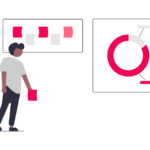As a publisher, you want to make sure your ad targeting is effective in order to maximize your revenue. But what is ad targeting? and what are the pros and cons of different ad targeting methods? Read on to find out.
While shopping on an online platform, you check out a pair of shoes. But didn’t purchase it and moved on. After a while, you saw the same pair of shoes on your social account as a sponsored ad. It’s a simple example of ad targeting that most of us have experienced.
But marketers are not really interested in bombarding a visitors’ screen with multiple ads. Also, publishers do not want their visitors to be annoyed with unnecessary ads.
They both want to display ads that get a valuable impression and conversion. For that, ads are needed to be placed strategically using audience targeting. What is Ad Targeting? Here’s what you need to know.
What Is Ad Targeting?
Display ads are created with the
For that, marketers break the entire market into small segments and then work on each segment individually. Generally, targeting depends on the business type. Due to this, marketers often create their own ad targeting methods. However, the basic types are:
- Contextual targeting
- Behavioral targeting
- Demographic targeting
- Technical targeting
These methods are combined to create advanced ad targeting techniques that might better suit a specific business.

Let’s start by understanding each of these ad targeting types:
1. Contextual Targeting
Contextual advertising is a type of advertising that takes into account the context of what a user is viewing and serves them ads accordingly. It’s a growing form of advertising: research conducted by MarketsandMarkets predicts that it will reach USD 297.68 by 2023.
The displayed ads are more or less similar to the content displayed on the web page. Contextual targeting is known by names, viz. ‘in-text’ and ‘in-context’ targeting.
Suppose you are visiting a car website and exploring the various models. You see car insurance ads being displayed on that web page. This is a contextual ad based on the idea that people having cars might also want car insurance.
As you can see, these ads are being targeted based on the type of website and its content.
Pros:
- Rich media ads can be placed as inventory gets valued impressions
- Less disruption and increases the chances of getting clicks
- Complements content, hence increasing conversion
- Collects minimal user information depending on the cookies policy of the website
- Publishers can sell inventories at a better price using programmatic direct or private auctions.
Cons:
- Precise contextual targeting is not possible.
- It can’t be applicable to websites with a broad context.
- Finding contextually relevant advertisers can be difficult for publishers.
2. Behavioral Targeting
Here, users’ online behavioral data is collected and used to show relevant ads to them. This technique involves gathering data from a variety of sources about the potential customers’ online browsing and shopping behavior. The collected data can be:
- Websites and pages viewed
- Search History
- Clicks (on ads, content, and links)
- Purchase history
- Frequently searched terms and visited websites
- Previous interactions with publishers’ websites
In behavioral targeting, every visitor is considered unique. However, campaigns are designed by grouping visitors based on their similar behavior. Most data is collected from 1st party i.e. publisher website cookies.
Pros:
- High click-through and conversion rate
- A detailed customer profile can be created using collected data
- Publishers have a better chance to monetize their display inventory
Cons:
- With General Data Protection Regulation (GDPR) in action, behavioral targeting might face security-related challenges
- Some users are not comfortable with sharing their online activity
- Ineffective when users have cookie-blocking software on their device

3. Demographic Targeting
Demographic targeting works with a more personal aspect of the users. This method uses age, gender, location, education, languages known, educational background, etc., for ad targeting. The data is collected using cookies, almost the same as
Using this data, visitors are segmented, and ads are targeted based on their demographics. For instance, if you are a woman athlete, then demographic targeting will make sure you don’t receive workout ads designed for men.
Pros:
- Ads can be personalized as per users and get better impressions
- Instantly grabs user attention
- High click-through (CTRs) and conversion rates
- A detailed customer profile can be created
Cons:
- Raises privacy concerns
- Not 100% accurate with users’ information
- Ineffective when users have cookie-blocking software on their device
- As the information is collected using website cookies, the publisher will face the consequences in case of a data leak.
4. Technical Targeting
Technical targeting concerns the device type, operating system, network, and data connection of the users’ devices. The first and most important segmentation is based on device type i.e. desktop or smartphone. And then users are grouped based on other technical aspects.
For example, Facebook has another application for users having slow internet connection. Using this information, Facebook shows minimal media ads that are easy to load on slow internet speed. While on the other hand, users with a good Wifi connection see rich-media advertisements.
Pros:
- Utilizes rich media ads by showing them only where they get valuable impressions
- Easily segments high-value customers
- Collects minimal personal information of the users, hence avoiding any privacy issues
- Publishers can take benefit from technical targeting by optimizing their websites for users with low network connections.
Cons:
- Not effective for all business models
- Only deals with the technical aspect of the user demographics
- Impressions and click rates are unpredictable
Privacy Concern
Targeting in marketing is often associated with privacy concerns. Many users are not comfortable with sharing personal information. But, to access the content, they are forced to accept cookies which are later used to extract their online behavior.
Publishers assure that the data collected by them are going to be stored safely. However, we see numerous data leak cases, every year. This means, data fraud exists. And no matter what security measure is used, fraudsters will find their way in and cause harm to the system.
But from publishers’ and marketers’ points of view, it is important to target users to uplift revenue. The dilemma is real. However, for now, audience targeting is the best and most fruitful method in the ad industry.

Benefits of Ads Targeting
Now that you have understood what is ad targeting let’s take a look at some of its benefits.
Bringing Better Personalization
Personalization is the key to making the most of your ad spending. It has become one of the most sought-after tools in digital marketing. Its effects on customer acquisition and retention, click-through rate (CTR), and customer lifetime value (CLV) are well-documented. Research conducted by adducent also revealed that 71% of consumers prefer personalized ads.
Ad personalization allows you to target ads to customers based on their individual interests, which can result in more sales and loyal customers.
Targeted advertising is a great way for brands to connect with their customers on a personal level. By tailoring their messaging to specific consumers, brands can show that they understand what their customers want and need.
This, in turn, increases the likelihood that customers will respond to advertising and engage with the brand.
Streamlining Your Marketing Efforts
Generic advertising is often less effective and more costly than targeted advertising. But that’s not the case with targeted ads.
Targeted ads help focus resources on the most rewarding audience groups, which results in getting the maximum out of each piece of creative content a brand publishes online.
Ads that are targeted at specific audience segments can be a great way to attract high-potential customers to your brand.
This ad targeting automation can help make sure that your ads are published quickly and easily, so you can focus on other aspects of your business.
Increased ROI on Marketing Spends
Targeted advertisements are a great way to reach consumers with who they are already engaged. By collecting data about customers, such as demographics, interests, and behavior trends, advertisers can create ads that are more likely to resonate with their target audience.
This helps to ensure that consumers are approached in the way they prefer, making the advertising more effective overall.
Using customer data to guide your decisions about acquiring new customers can save you time and money. By understanding who your target customer is and what they are looking for, you can focus your efforts on acquiring users who are more likely to convert.
Increased Brand Awareness
As mentioned earlier, personalization and ad targeting is the key. If a brand’s ads are not well-targeted or relevant, potential customers will definitely take notice. Cramming a customer’s browser with ads that are not relevant to them will result in damaging the brand’s reputation in their eyes.
Conversely, brands will become more credible and trusted by improving their reputation by presenting relevant ads and valuable content to the audiences. It’s because that will be more appreciated by the audience.
This way, audiences get what they want (valuable content) and brands get what they want (a good reputation). It’s a win-win! We hope by now you have understood what is ad targeting and its types. Now, let’s delve into the future of ad targeting.
Future of ad Targeting
There is no doubt that ad targeting is here to stay. With the advent of new technologies, the future of ad targeting is only going to become more sophisticated and effective.
Ad targeting allows businesses to specifically target their advertising to reach the consumers most likely to be interested in their products or services. This not only results in saving businesses money but also ensures that their advertising is more effective.
Furthermore, new technologies such as Virtual Reality and Augmented Reality are likely to become more widely used in advertising, further enhancing the effectiveness of ad targeting.
So this was all you needed to know about what is ad targeting and its types. Thanks for reading. For more information, please refer to the following FAQs.
Frequently Asked Questions for Ad Targeting
Here’s the short and simple answer to what ad targeting is.
An ad targeting strategy is a plan for how to select the people who will see your ads. When you create an ad campaign, you can choose to target a specific group of people based on factors like age, location, gender, interests, and more.
By carefully targeting your ads, you can ensure that they are seen by the people most likely to be interested in your product or service.
The four main types of ads are as follow:
Display advertising
It is a type of online advertising that involves the use of banner ads, text ads, and other graphical ads that are displayed on websites.
Video advertising
It’s a type of online advertising that involves the use of video clips to promote products or services.
Mobile Advertising
Mobile advertising is a type of online advertising that involves the use of mobile devices to deliver ads. ‘
Native advertising
It is a type of online advertising that involves the use of native elements, such as text, images, and video, to promote products or services.
There is no doubt that targeted advertising is more effective than untargeted advertising. When you target your ads, you are more likely to reach your target audience, and this can lead to increased sales and brand awareness. However, targeted advertising is not without its drawbacks.
First, it can be more expensive than untargeted advertising.
Second, it can be more difficult to track the results of your targeted campaign, making it difficult to measure its effectiveness. Overall, though, targeted advertising is worth the investment if you want to reach your target audience and boost your sales.

Shubham is a digital marketer with rich experience working in the advertisement technology industry. He has vast experience in the programmatic industry, driving business strategy and scaling functions including but not limited to growth and marketing, Operations, process optimization, and Sales.





![28 Best Supply Side Platforms (SSP) for Publishers in 2024 [The Complete List] Supply Side Platforms](https://www.adpushup.com/blog/wp-content/uploads/2022/05/undraw_chore_list_re_2lq8-270x180.png)


1 Comment
Pingback: What Publishers Need To Know About The CCPA - Business Partner Magazine